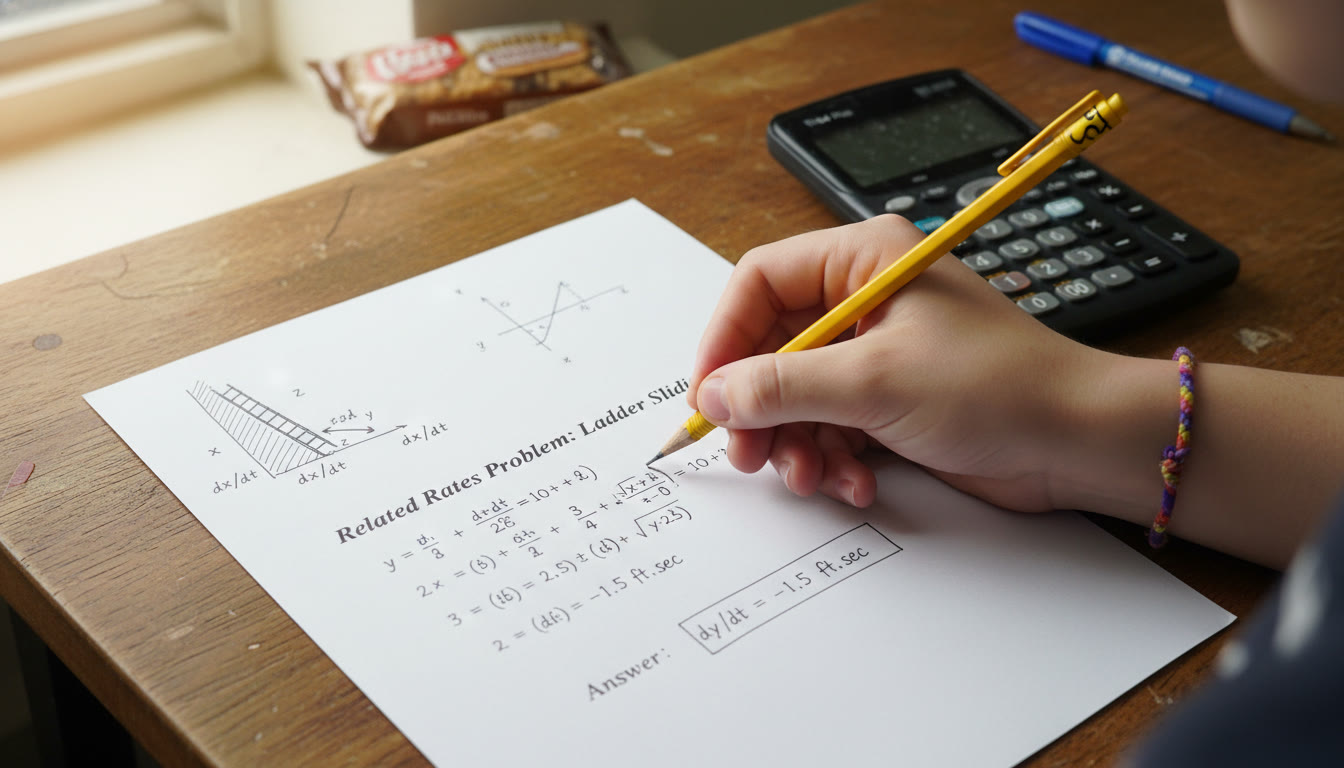Why Function Behavior Is the Heart of AP Calculus
Think of calculus as a language for change. If algebra tells you where things are, calculus tells you how they move, bend, and behave. For AP Calculus—whether AB or BC—the core skills you’ll be tested on revolve around understanding functions from multiple perspectives: graphically, numerically, algebraically, and verbally. That’s why mastering graphs, limits, and rates isn’t optional; it’s essential.
In this post I’ll walk you through the intuitive ideas, give you practical problem-solving habits, and share classroom-tested strategies to help you approach AP questions calmly and clearly. Along the way you’ll find examples, a handy table summarizing common behaviors, and study tips including how personalized support—like Sparkl’s 1-on-1 guidance and tailored study plans—can accelerate your progress if you choose that route.
Big Picture: Four Lenses for Looking at a Function
Before we dive into limits and derivatives, adopt this mental toolkit: every function can be described in four equivalent ways. Train yourself to shift between them.
- Graphical: The picture of the function—peaks, valleys, asymptotes, intercepts.
- Algebraic: Formulas and manipulations—what you compute with pencil and paper.
- Numerical: Tables of values showing trends, increments, and patterns.
- Verbal (Contextual): A sentence-based description, e.g., “the population grows faster as time increases; growth slows after year five.”
AP exam questions love to mix these representations—one part graph, one part equation, one part context. Your job is to translate between them quickly and accurately.
Limits: The Gateway to Instantaneous Behavior
What a Limit Really Means
A limit describes what a function approaches as the input gets near some value. It’s not about the function’s value at that point; it’s about the approach. That subtle idea unlocks continuity, derivatives, and a lot of AP problems where functions are not defined at a point but still have predictable behavior nearby.
Visual and Numerical Intuition
Two quick ways to build intuition:
- Graphically: Zoom in on the graph near the point. If the y-values lean toward a single number from both sides, that’s the limit.
- Numerically: Make a table of x-values approaching the point from left and right. If the function values converge, you’ve likely found the limit.
Example: f(x) = (x^2 − 1)/(x − 1). At x = 1 the expression is undefined, but algebraic simplification f(x) = x + 1 for x ≠ 1 shows the limit as x → 1 equals 2. On a graph the hole at (1,2) is a dead giveaway.
Common Limit Situations on AP
- Limits at infinity — look for horizontal asymptotes; rational function leading terms dominate.
- One-sided limits — especially around vertical asymptotes or piecewise definitions.
- Indeterminate forms like 0/0 — typically resolved by algebra, factoring, conjugates, or L’Hôpital’s Rule (where applicable).
Continuity: When Limits Match Values
A function is continuous at a point if the limit exists there and equals the function’s value. Continuity ties together the algebraic and graphical worlds and is often tested directly or implicitly on AP exams—especially where piecewise functions, absolute values, or domain restrictions appear.
Checklist to Test Continuity at a Point a
- Is f(a) defined?
- Does lim_{x→a} f(x) exist?
- Is lim_{x→a} f(x) = f(a)?
If any step fails, the function is discontinuous at a. On the AP exam, be comfortable identifying removable discontinuities (holes), jump discontinuities, and vertical asymptotes.
Derivatives as Rates: From Slope to Instantaneous Change
Derivative Intuition: The Slope of the Tangent
When you learned slope in algebra, you computed a change across an interval. The derivative is the limit of that slope as the interval shrinks.
Derivatives are everywhere on AP: velocity as the derivative of position, marginal cost as derivative of total cost, and the slope of a curve at a point when sketching graphs. The exams often want you to interpret derivatives in context—what does f'(3) = −4 say about a population model? (Answer: near time 3 the population is decreasing at a rate of 4 units per time unit.)
Common Derivative Tasks on AP
- Compute derivatives using power, product, quotient, and chain rules.
- Use implicit differentiation for equations not solved for y.
- Apply derivatives to related rates and motion problems.
- Interpret derivatives graphically (e.g., where f'(x) > 0, f is increasing).
Graphical Relationships: f, f’, and f”
One of the most powerful skills in AP Calculus is reading three related graphs: a function f, its derivative f’, and its second derivative f”. Once you learn the signatures—how zeros and signs line up—you can infer a lot without heavy computation.
Quick Mapping Rules
- If f'(x) > 0 then f is increasing there; if f'(x) < 0 then f is decreasing.
- Critical points: where f'(x) = 0 or f’ is undefined. These are candidate maxima/minima or points of inflection.
- For concavity: if f”(x) > 0, f is concave up; if f”(x) < 0, f is concave down.
- Inflection points occur where f” changes sign (not just where f” = 0).
Table: Common Function Behaviors and What to Check
| Graphical Feature | What It Suggests | AP Tools to Use |
|---|---|---|
| Hole at x = a | Limit exists but function undefined or value different | Factor, simplify, evaluate limit |
| Vertical asymptote | Unbounded behavior → limit ±∞ or DNE one-sided | Analyze denominator; check one-sided limits |
| Horizontal asymptote | Limit as x → ±∞ equals constant | Compare leading terms for rational functions |
| Cusp or corner | Derivative undefined (f’ DNE) though function continuous | Check left and right derivatives |
| Flat tangent (f’ = 0) | Local max/min or plateau—need sign test or second derivative | First derivative sign chart; second derivative test |
Limits and Continuity in Context Problems
AP exam problems often wrap limits into word problems. Here’s a practical approach:
- Translate words to a function or limit expression (identify which variable approaches what).
- Decide whether you should analyze algebraically, graphically, or numerically.
- Check one-sided behavior if the problem suggests directional change (e.g., approach from the left only).
- Interpret your result back into the context—the numerical answer needs a verbal meaning.
Example: A water tank’s volume V(t) behaves like V(t) = (t^3 − 2t)/(t − 0) for t near 0. If you want the instantaneous rate of change at t = 0, compute the derivative limit or simplify first. The exam will expect you to link the computation to a unit (e.g., liters per minute).
Strategies to Sketch Graphs from Function Rules
When an AP question asks you to sketch f(x) or f'(x), use this step-by-step checklist:
- Domain: Look for restrictions (square roots, denominators, logs).
- Intercepts: Set x = 0 and y = 0 to find points where the graph crosses axes.
- Asymptotes: Check limits at ±∞ and vertical asymptotes from zeros in denominators.
- Critical points: Solve f’ = 0 and analyze signs for increasing/decreasing intervals.
- Concavity and inflections: Use f” to find where concavity changes.
- Plot a few key points and sketch using continuity and concavity cues rather than trying to plot many points.
Rates of Change: From Position to Practical Applications
Derivatives are often introduced physically (position → velocity → acceleration), but AP loves applying them elsewhere: economics (marginal cost, revenue), biology (population growth rate), and geometry (related rates like ladder problems). The trick is setting up the relationship between variables carefully.
Related Rates: A 4-Step Recipe
- Draw a diagram and label all variables.
- Write the equation relating the variables (geometry formulas are common).
- Differentiate both sides with respect to time (or the given independent variable).
- Substitute known values and solve for the unknown rate.
Don’t rush the setup. Most mistakes come from an incorrect relation, not algebra after differentiation.
Common Mistakes and How to Avoid Them
- Confusing limit with function value—always ask: does the function actually exist at that point?
- Using algebraic shortcuts without checking domain—simplifying can remove information about holes or vertical asymptotes.
- Mixing up f’ sign and concavity—f’ sign gives increasing/decreasing; f” gives concavity.
- For word problems, failing to attach units. Always include units in context problems and interpret your result.
Practice Problems With Solutions (Guided)
Problem 1: Limit and Hole
Let f(x) = (x^2 − 4)/(x − 2). Find lim_{x→2} f(x).
Solution sketch: Factor numerator to (x − 2)(x + 2), cancel (x − 2) for x ≠ 2, leaving f(x) = x + 2. So the limit equals 4. Graphically, picture a line y = x + 2 with a hole at (2,4).
Problem 2: Derivative as a Rate
Position of a particle is s(t) = t^3 − 6t^2 + 9t (meters). Find velocity at t = 2, and interpret.
Solution sketch: v(t) = s'(t) = 3t^2 − 12t + 9. Then v(2) = 3(4) − 24 + 9 = 12 − 24 + 9 = −3 meters per second. Interpretation: at t = 2s the particle is moving backward at 3 m/s.
Exam Strategy: How to Tackle AP Questions Efficiently
Time is a pressure point on AP exams. Here are habits that save minutes and points:
- Read the question fully before doing algebra. Identify exactly what is asked (limit, continuity, derivative value, interval behavior).
- For multi-part problems, label each answer clearly and reuse work—AP graders reward clear organization.
- When a graph is given, use it—estimate slopes visually for derivative values, check sign charts, and mark asymptotes or holes.
- Know when to compute symbolically versus approximating numerically. If a neat algebraic simplification exists, do it. If the function is complicated and the question asks for an approximate rate, a numerical table can be faster and acceptable in context.
- Use units to check plausibility. If you compute a rate with nonsensical units or sign, go back and check orientation and setup.
How to Build Deep Understanding (Study Plan)
Rather than cramming formulas, aim for layered mastery. Here’s a three-week micro-plan you can adapt to your pace:
- Week 1 — Foundations: Limits and continuity. Focus on epsilon-delta intuition (conceptually), algebraic limit techniques, and practice 20–30 small problems daily.
- Week 2 — Derivatives and Graphing: Rules of differentiation, relation between f and f’, and sketching exercises. Do a mix of computational and interpretive problems.
- Week 3 — Applications and Test-style Practice: Related rates, optimization, and mixed representation tasks. Time yourself on multiple-choice style sets and free-response practice.
Pair this plan with frequent self-quizzing: write quick concept flashcards (e.g., “If f’ changes from + to − at a, what is a?”) and force yourself to explain concepts out loud. You’ll be surprised how much clearer the ideas become when you can teach them in a sentence or two.
Tools and Resources to Speed Up Learning
Graphing calculators and dynamic graphing tools are your friends—use them to visualize limits and see how the graph behaves near problem points. But don’t outsource conceptual understanding to the calculator: the AP exam expects you to explain and often justify results analytically.
If you find gaps in timing, concept clarity, or problem selection, personalized help can be a game-changer. Sparkl’s personalized tutoring offers expert tutors, 1-on-1 guidance, tailored study plans, and AI-driven insights to target weak spots efficiently—especially useful when you need to convert conceptual knowledge into exam-ready skills.

Putting It Together: A Mock Free-Response Scenario
Imagine the AP free-response gives a graph of a continuous function g(x) with a peak at x = 1, a root at x = 3, and a vertical asymptote near x = −2. The parts ask you to:
- Estimate g'(1) and justify your estimate.
- Identify intervals where g is concave up and concave down.
- Explain what happens to g'(x) as x approaches −2 from the right.
Approach:
- For g'(1), sketch a tangent line at x = 1 and compute slope from rise/run using nearby grid points—be explicit with the number and units if given.
- Concavity: find where the slope increases or decreases. Where slopes are getting larger, g is concave up; where slopes fall, concave down. Mark inflection points where slope behavior changes.
- Near the vertical asymptote at x = −2, explain whether slopes blow up to ±∞ or approach finite limits depending on the graph—give a one-sentence justification relating the steepness of the curve to derivative behavior.
Write answers in short bullets and label each with the part letter; clarity and justification score points.
Practice Smart: Quality Over Quantity
High-quality practice means deliberately solving problems that target the ideas you struggle with. If you’re shaky on limits at infinity, work a set of rational-function problems until leading-term rules are automatic. If interpreting graphs stresses you out, practice sketching a given f’ and hypothesizing about f, then check by differentiating a plausible parent function.
Consider rotating practice modes: one session devoted purely to computation, the next to verbal interpretations, the third to timed mixed sets. This trains both accuracy and the speed needed on exam day.
Final Checklist for Exam Day: Function Behavior
- When asked for a limit, always consider one-sided limits if there might be an asymptote or piecewise jump.
- Label units on rate-of-change answers and interpret the sign (positive or negative indicates increasing or decreasing).
- Use first- and second-derivative tests where appropriate; show work for critical points and concavity decisions.
- Sketch neat, labeled graphs when asked—clear visuals earn partial credit even if algebraic work has an error.
- If time is tight, prioritize clear conceptual explanations and labeled sketches—AP readers value correct reasoning as much as final numbers.

Wrapping Up: From Confusion to Confidence
Function behavior—how graphs move, how limits behave, and how derivatives describe rates—isn’t a collection of isolated tricks. It’s a coherent framework that, once internalized, turns intimidating problems into manageable steps. Practice translating between representations, annotate graphs carefully, and always tie computations back to context and units.
If you want to accelerate that learning curve, targeted, personalized support can make the difference. Tutors who focus on your unique misconceptions, short tailored practice sets, and AI-driven feedback (like the kind offered in some modern tutoring programs) help turn scattered understanding into reliable exam performance. Sparkl’s personalized tutoring can provide that 1-on-1 guidance and structured plan if you decide that extra boost would help you reach your AP goals.
Stay curious, practice intentionally, and remember: calculus rewards the student who thinks visually and then checks algebraically. You’ve got this—one limit, one derivative, and one well-labeled graph at a time.
Quick Reference: Key Formulas and Reminders
- Definition of derivative: f'(a) = lim_{h→0} [f(a+h) − f(a)]/h
- Common derivatives: d/dx[x^n] = nx^{n−1}; d/dx[sin x] = cos x; d/dx[e^x] = e^x
- Chain rule, product rule, quotient rule—know when to apply each and practice several mixed-rule problems.
- L’Hôpital’s Rule helps with ∞/∞ and 0/0 indeterminate forms but make sure prerequisites are satisfied.
Good luck on your AP journey—practice thoughtfully, keep your explanations crisp, and let your graphs tell the story behind the algebra.























No Comments
Leave a comment Cancel